
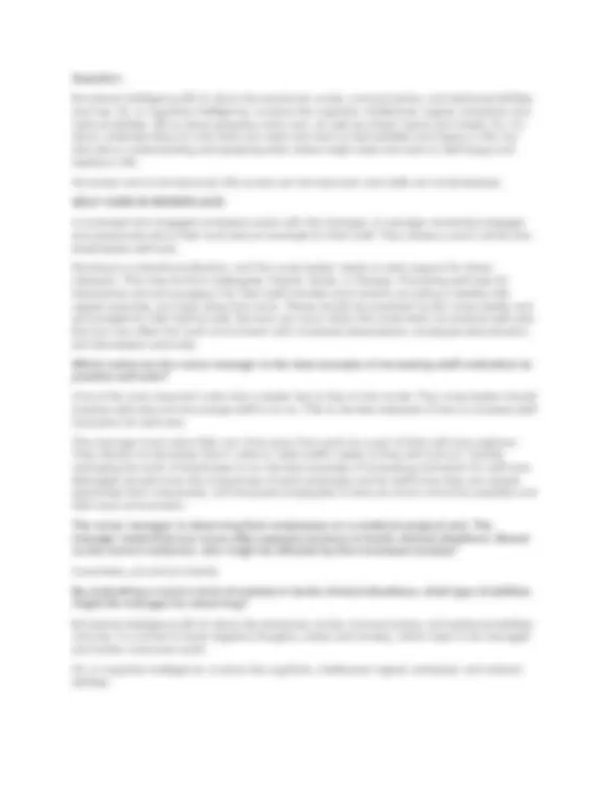
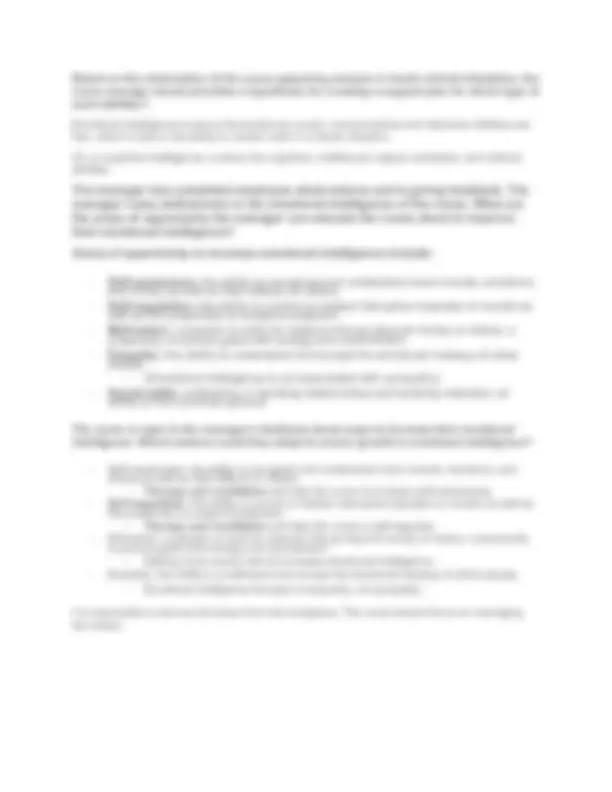
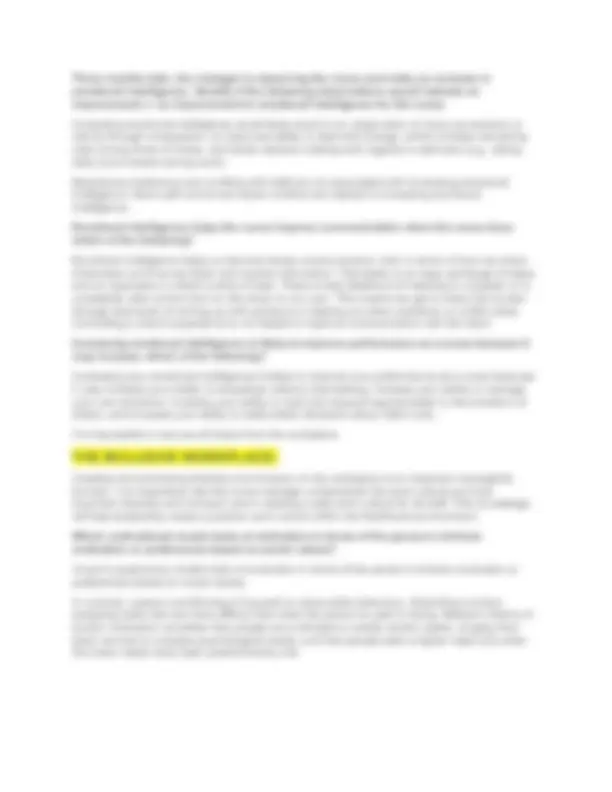
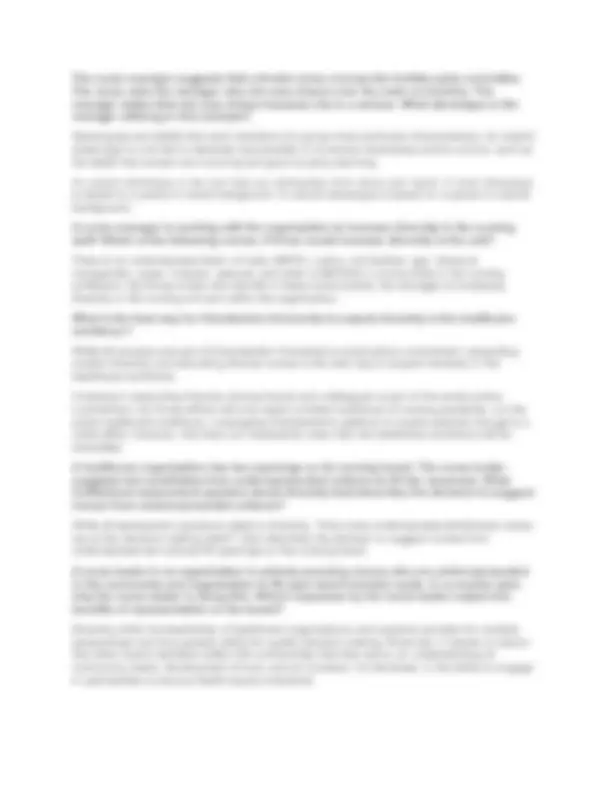
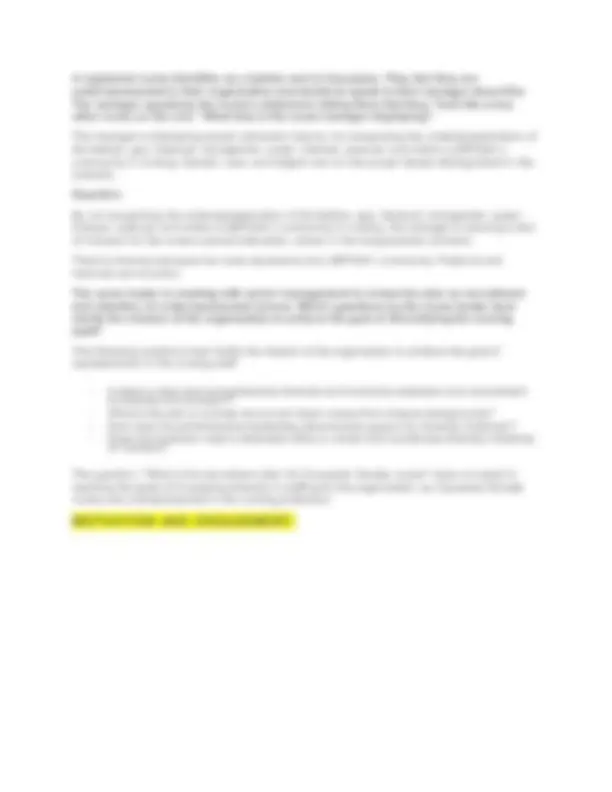



Study with the several resources on Docsity

Earn points by helping other students or get them with a premium plan


Prepare for your exams
Study with the several resources on Docsity

Earn points to download
Earn points by helping other students or get them with a premium plan
Community
Ask the community for help and clear up your study doubts
Discover the best universities in your country according to Docsity users
Free resources
Download our free guides on studying techniques, anxiety management strategies, and thesis advice from Docsity tutors
NR 446 WEEK 4 EDAPT NOTESLEADING TEAMTHE WORK CULTURE-With 100% Verified Solutions
Typology: Exams
1 / 10

This page cannot be seen from the preview
Don't miss anything!







LEADING TEAM THE WORK CULTURE: Nurses can prevent burnout on the job by practicing which habit? Self-care is needed to prevent burnout. The nurse should use accrued time off to seek time away from work. Frequently working overtime and avoiding asking for assistance from colleagues will promote burnout, not prevent it. Which are true about advocacy? Advocacy helps others grow and self-actualize and it is part of a leadership role. Leaders, by virtue of their many roles, must advocate for clients, subordinates, and the profession. What can a leader do to promote employee self-care in the workplace? A manager/leader should encourage the use of accrued time off to seek time away from work to prevent burnout. Healthy snacks and breaks from the unit will help promote self-care. Covering employees throughout the day so they can take a break will not only promote self-care, but it will also assist with employee and unit morale. Taking an adequate lunch break and time off throughout the year does promote self-care and prevents burnout. ADVOCACY: Advocacy is an important part of the nurse leader role. Just as a nurse advocate for their clients, leaders must advocate for their subordinates and themselves. The nurse leader must also advocate for the nursing profession and career advancement. By advocating, the nurse leader is helping others grow and self-actualize. Nursing Leadership Responsibilities with Advocacy
Nurse leaders must understand the concept of emotional intelligence (EI) as well as recognize it in themselves and others. EI differs from intellectual intelligence in that it is the ability to successfully deal with people and the environment despite complex challenges. EI develops over time and can be increased. Five Components of Emotional Intelligence
Based on the observation of the nurse appearing anxious in hectic clinical situations, the nurse manager would prioritize a hypothesis for creating a support plan for which type of work abilities? Emotional intelligence is about the emotional, social, communicative and relational abilities one has, which is tied to the ability to remain calm in a hectic situation. IQ, or cognitive intelligence, is about the cognitive, intellectual, logical, analytical, and rational abilities.
The nurse is open to the manager’s feedback about ways to increase their emotional intelligence. Which actions could they adopt to ensure growth in emotional intelligence?
Three months later, the manager is observing the nurse and notes an increase in emotional intelligence. Identify if the following observations would indicate an improvement or no improvement in emotional intelligence for the nurse: Increasing emotional intelligence would likely result in an observation of more connections to clients through compassion, an improved ability to deal with change, which includes remaining calm during times of stress, and better decision making with regards to self-care (e.g., taking daily lunch breaks during work). Reactionary behaviors and conflicts with staff are not associated with increasing emotional intelligence. More self-control and fewer conflicts are related to increasing emotional intelligence. Emotional intelligence helps the nurse improve communication when the nurse does which of the following? Emotional intelligence helps us become better communicators, both in terms of how we share information and how we listen and receive information. That leads to an easy exchange of ideas and an openness to others' points-of-view. There is less likelihood of needing to compete or to completely take control and run the show on our own. This means we get to share the burden through teamwork of coming up with solutions or helping out when problems or conflict arise. Controlling a client's experience is not helpful to improve communication with the client. Increasing emotional intelligence is likely to improve performance as a nurse because it may increase which of the following? Increasing your emotional intelligence is likely to improve your performance as a nurse because it may increase your ability to empathize without internalizing, increase your ability to manage your own emotions, increase your ability to read and respond appropriately to the emotions of others, and increase your ability to make better decisions about client care. It is impossible to remove all stress from the workplace. THE INCLUSIVE WORKPLACE: Creating and promoting diversity and inclusion in the workplace is an important managerial function. It is imperative that the nurse manager understands the work culture and how important diversity and inclusion are in creating a safe work culture for all staff. This knowledge will help leadership create a positive work culture within the healthcare environment. Which motivational model looks at motivation in terms of the person’s intrinsic motivation or preferences based on social values? Vroom’s expectancy model looks at motivation in terms of the person’s intrinsic motivation or preferences based on social values. In contrast, operant conditioning is focused on observable behaviors. Stretching involves assigning tasks that are more difficult than what the person is used to doing. Maslow’s theory of human motivation considers that people are motivated to satisfy certain needs, ranging from basic survival to complex psychological needs, and that people seek a higher need only when the lower needs have been predominantly met.
Which population demographics are overrepresented in the nursing workplace? Nursing population demographics are overrepresented among female, heterosexual, Caucasian nurses. Male, black, indigenous, and people of color (BIPOC), Latinx, and lesbian, gay, bisexual, transgender, queer, intersex, asexual, and other (LQBTAI+) populations are underrepresented in nursing. Nursing has a lack of representation from the BIPOC population. The Native American, African American, and black nurses are represented in the BIPOC group. There is also a lack of gender representation among the LGBTQIA+ population. Transgender, nonbinary, and homosexual nurses are represented in the LGBTQIA+ group. Latinx is a person of Latin American origin or descent (used as a gender-neutral or nonbinary alternative to Latino, Latina, or Hispanic). What questions should be answered when conducting an institutional assessment of diversity? The following questions best clarify the mission of the organization to achieve the goal of representation in the nursing staff:
The nurse manager suggests that a female nurse oversee the holiday party committee. The nurse asks the manager why she was chosen over the male co-workers. The manager states that she was chosen because she is a woman. What stereotype is the manager utilizing in this example? Stereotypes are beliefs that most members of a group have particular characteristics. An implicit stereotype is one that is relatively inaccessible to conscious awareness and/or control, such as the belief that women are nurturing and good at party planning. An explicit stereotype is the kind that you deliberately think about and report. A racial stereotype is based on a person’s racial background. A cultural stereotype is based on a person’s cultural background. A nurse manager is working with the organization to increase diversity in the nursing staff. Which of the following nurses, if hired, would increase diversity in the unit? There is an underrepresentation of male, BIPOC, Latinx, and lesbian, gay, bisexual, transgender, queer, intersex, asexual, and other (LGBTQIA+) communities in the nursing profession. By hiring nurses who identify in these communities, the manager is increasing diversity in the nursing unit and within the organization. What is the best way for Chamberlain University to expand diversity in the healthcare workforce? While all answers are part of Chamberlain University's social justice commitment, expanding student diversity and educating diverse nurses is the best way to expand diversity in the healthcare workforce. Investing in expanding diversity among faculty and colleagues is part of the social justice commitment, but those efforts will only assist a limited workforce of nursing academia, not the entire healthcare workforce. Leveraging Chamberlain's platform to inspire external change is a noble effort; however, that does not necessarily mean that the healthcare workforce will be diversified. A healthcare organization has two openings on its nursing board. The nurse leader suggests two candidates from underrepresented cultures to fill the vacancies. What institutional assessment question about diversity best describes the decision to suggest nurses from underrepresented cultures? While all assessment questions relate to diversity, “How many underrepresented/diverse voices are at the decision-making table?” best describes the decision to suggest nurses from underrepresented cultures fill openings on the nursing board. A nurse leader in an organization is actively pursuing nurses who are underrepresented in the community and organization to fill open board member seats. A co-worker asks why the nurse leader is doing this. Which responses by the nurse leader explain the benefits of representation on the board? Diversity within the leadership of healthcare organizations and systems provides for multiple perspectives and thus greater ability for quality decision-making. Moreover, it stands to reason that when board members reflect the communities that they serve, an understanding of community needs, development of trust, and an increase, not decrease, in the ability to engage in partnerships to ensure health equity is fostered.